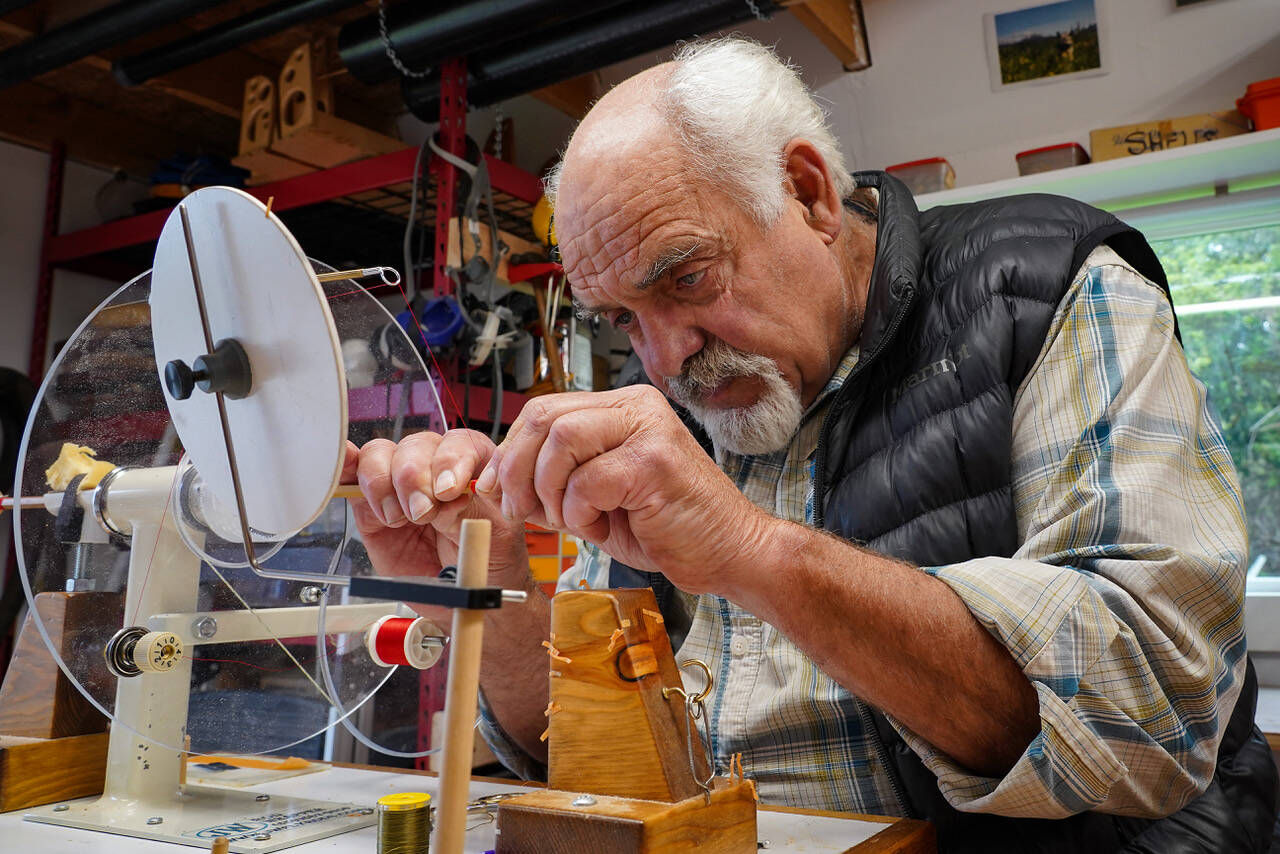When Jon Lyman sets out to build a fly fishing rod, his aim is to make it last for generations.
The South Whidbey resident has been hooked on making the custom bamboo rods since 1999, when he learned the craft from master builder Ralph Moon, a fly fishing legend and author.
Lyman, who moved to the island a year ago after spending the past 54 years in Alaska, is something of a legend himself. His passion for fly fishing is palpable and his knowledge of the sport is extensive; he spent a decade writing a column for Flyfisher magazine and has published several papers on the activity in fisheries journals worldwide.
Lyman fashions his rods out of tonkin cane and hardwoods from around the globe, adorning them with silk windings and sterling silver from his collection of antiques. There are about 600 steps to building a rod, and he estimated that it takes him between 40 and 60 hours to complete each one.
Bamboo fibers, he explained, are strong as steel when combined. He planes the strips by hand, staggering the nodes of the bamboo for strength.
“You take a graphite rod, you nick it on something that’s going to blow up on the next good fish,” he said. “These things will still be fishable for 100 years.”
With any luck, future generations will enjoy Lyman’s rods long after he is gone. When he served as the education vice president for the Federation of Fly Fishers – now known as Fly Fishers International – Lyman would often get phone calls from widows asking what they should do with their late husbands’ fishing gear.
“Nine out of 10 times, it would go in garage sales, and who he was, was totally devalued and lost,” Lyman said.
So he started making what he calls legacy rods – rods that honor anglers in unique ways that can be handed down to family members. He does this by letting the fisher select a piece of sterling silver from his collection of antique spoons, buttons, rings and medallions. After shaping the silver, he then affixes it to the end of the rod in the form of ring and cup reel holders.
His silver spoons, for example, have a vast array of images imprinted on them, from wildlife to national parks to cowboys to characters from mythology.
“You tell me your story – are you a miner, are you a fisherman, where’s the favorite place to fish. I use the silver to try and tell your story on your rod, your favorite colors of silk. The rod is designed to fish where you like to fish by taper, what kind of thing that you chase,” Lyman said. “You get done with it and it becomes an heirloom. Your son’s not going to want to fish – they never do – but your grandson’s gonna love it.”
He peruses local thrift stores in order to add to his growing collection of silver.
“You find these everywhere,” he said of the spoons, which he collects in the largest number. “I’m always looking. The idea is to have stock so that when people have those interesting stories, it doesn’t take me forever to find material to fill them in.”
Lyman’s rods are in the hands of anglers all around the nation. He donates more than half of his rods to conservation organizations to help fund education and restoration projects.
Right now, he is working on a series he calls the Tlingit rods. Both Lyman and his wife were adopted by the Tlingit people when they moved to Angoon, Alaska in 1971 and became the first white teachers accepted into the village since an 1882 attack by U.S. Naval forces that destroyed the village.
Lyman worked for the Alaska Department of Fish and Game for 25 years and developed a program using fly fishing to teach environmental education, something he took from his experience in the indigenous villages.
Anglers accustomed to using graphite or fiberglass rods who try his bamboo rods have found fishing to be a totally different sport. While the former options are stiff and have a programmed method of casting, he said, the latter is a living material that’s more flexible.
“You take a good rod and if you listen to it, if you feel what’s going on, it will teach you how to cast. And the relationship with the fish, the life on the end of your line, is totally different,” Lyman said. “You’re going to feel every time it changes its fins, every time it moves its head, you’re going to feel that in the rod because it’s so much more sensitive.”
Over the years, the price of materials has drastically increased. Because of the amount of time, effort and materials that go into building a rod, Lyman charges upwards of $2,000.
Though he doesn’t get out to fly fish as much as he used to, Lyman is happy to continue building his legacy rods. He’s even willing to teach those who may be interested in learning the craft. In his lifetime, Lyman has made over 200 rods.
“I’m telling somebody’s story, and it’s going to outlive me,” he said.
Lyman’s rods can be seen in the Freeland Cafe and the Whidbey Art Gallery in Langley. For more information about his heirloom rods, visit jonlymanalaska.weebly.com.



